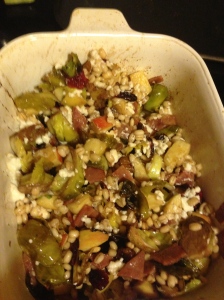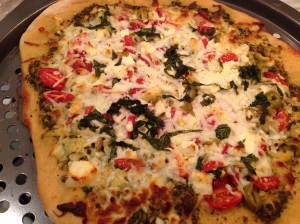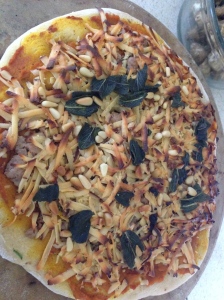This month I’ve been following the Mediterranean Diet. I’m not going to go into any great deal on the specifics of the diet in this post (I’ll save that for the next one). In short, the MedDiet is the traditional diet followed by the people that live along the Mediterannean Sea (go figure). It is characterized by LOTS of fresh fruits and veggies, poultry and fish, whole grains, lots of olive oil, nuts and seeds, a little bit of dairy, and very little red meat. And WINE!
I’ve had so much fun cooking over the last couple weeks, and I wanted to share some of my new recipes with you. As a reminder, please apply the term “recipe” loosely. I estimated the amounts of everything I used – I don’t measure. If you try something and don’t like it, it’s because I estimated incorrectly or because your tastebuds are broken. You can choose the culprit.
From Brussels, With Love
Brussels Sprouts are my favorite vegetable. If you just cringed, it’s because a) you’ve never actually had Brussels Sprouts or b) you haven’t had them made right. Brussels Sprouts have a really nice bitter, but subtle flavor and they marry well with both savory ands sweet flavors. The best combination out there is bacon and Brussels sprouts, but I like to add something sweet to balance it all out – typically dried cranberries or honey.
Here are a couple of my favorite ways to prepare B Sprouts. Try them out if you hate (or think you hate) them or if you just want a new way to prepare these delicious little cruciferous veggies!
Triple B’s: Brussels Sprouts, Barley, and Bacon
12-15 medium sprouts, ends and outer leaves removed, sliced in half along long axis
¼ cup walnuts, roughly chopped
2 T honey
2 T olive oil
1.5 T balsamic vinegar
2 T dried cranberries
1 apple, diced
¼ cup crumbled feta
3 slices bacon, cooked and chopped into small pieces
½ cup barley (I used 10 Minute Barley from Trader Joe’s)
Preheat oven to 400°F.
Whisk together honey, oil, and vinegar in a small bowl.
Combine sprouts and walnuts in a bowl and coat with sauce. Spread onto a roasting pan with all ingredients except bacon and barley. Roast in over for 30-35 minutes.
Meanwhile, cook and chop bacon and cook barley according to package directions.
When fruits, veggies, and nuts are soft, take out of oven, mix in barley and bacon, and eat up!
Toasted SooFoo with Brussels Sprouts and Baked Salmon
SooFoo can be found in the health food section of many grocery stores (I got mine at Safeway). It is a blend of brown rice; green, black, and brown lentils; rye and wheat berries; oats; barley; and buckwheat, making it a really tasty and great source of whole wheat grains. I’ve also seen something similar to this at Trader Joe’s – I think it’s called Harvest Medley, and it takes less time to cook, making this a very easy dish to throw together when you don’t have a ton of time.
I’ve already given my spiel about my love for Brussels Sprouts, so I won’t go into that again. Lastly, salmon is by far my favorite animal protein source. It’s such a diverse, mellow flavored fish, and I never tire of cooking it.
So here was my attempt at combining this strange mix of grains along with my favorite veggie and protein. I was pleasantly surprised at the result.
Serves 2-3
½ cup SooFoo
1 cup water
1 large salmon filet
~1-2 T olive oil
salt, pepper to taste
juice of half a lemon
7-8 brussels sprouts, outside leaves and stems discarded and cut into ribbons
~2 T pine nuts
~3 T dried cranberries
4-5 dried apricots, roughly chopped
~2 T parsley, roughly chopped
In a small/medium saucepan, bring water and SooFoo to a boil, reduce to simmer for 40-50 minutes. You know how it goes :).
Meanwhile, drizzle salmon filet with olive oil, sprinkle with salt and pepper, and squeeze lemon juice on top. Place in a cold oven, heat to 400°F, and take out in 25 minutes. This is the best way I know to cook salmon.
When SooFoo is nearly done, start sautéing Brussels Sprouts and pine nuts in just a bit of olive oil (you don’t want them to be soaking, just enough so they don’t burn). Sprinkle with salt and pepper. After about 3-4 minutes, add in the SooFoo and a little more oil in order to toast the grains. Stir occasionally to prevent burning. Mix in apricots, cranberries, and parsley. Season with salt and pepper to taste
Serve salmon over veggie, fruit, and grain mixture. Add parsley for garnish.
I ate this dish with a nice big glass of Cabernet Sauvignon, but I’m not going to pretend to know how to pair wine with food. Whatever makes you happy! J
My oh my, the Pizza Pie!
Everyone loves pizza! And what’s better than pizza? Homemade pizza, that’s what! It’s so easy (and cheap) to make at home, and I don’t take advantage of it nearly enough. If you don’t want to make the dough, you can buy it in the freezer section at some grocery stores (Sprouts definitely has it; I haven’t checked elsewhere). I really like making it, though, because it’s fun to see the whole thing come together from scratch. Here are a couple of my most recent concoctions.
Use this recipe for Whole Wheat-ish Pizza Dough. This will make enough dough for two pies. You can easily halve it or you can just save the dough in a Ziploc bag – just make sure to squeeze all the air out of the bag. I kept mine for 3 days in between pies; I don’t know how much longer it would last.
Pesto Mediterranean Pizza
Whole wheat pizza dough (see above link)
Pesto (make from scratch by blending together some basil and olive oil until you get the consistency you want, add pine nuts/walnuts, salt and pepper to taste.)
Marinated artichoke hearts, sliced into ribbons
Marinated garlic stuffed olives, roasted red peppers, diced
6-8 cherry tomatoes, cut into quarters
1.5 cups mozzarella cheese (I use 2% milk fat)
½ cup feta cheese
basil chiffonade
Preheat oven to 425°C.
This is pretty much a free for all. Roll out the dough on a countertop covered in flour. If you’re feeling adventurous, do some tosses to make the pie. I didn’t do that.
Transfer the dough to a pizza stone or pan.
Spread pesto (however much you want) onto dough. Cover pesto with veggies (the veggies I bought were just marinated in jars. I got them from Safeway, but use whatever you want. There are no rules here).
Top veggies with mozzarella and feta cheeses and chiffonade basil leaves
Bake for ~15 minutes or until cheese is melted and crust is lightly browned.
Pumpkin, Spicy Sausage, Fried Sage, and Smoked Gouda Pizza
Whole wheat pizza dough (see above link)
~1 cup pureed pumpkin
nutmeg and fresh ground pepper to taste
1 spicy turkey sausage, fried and crumbled
2 T olive oil, separated
1 cup smoked gouda, shredded
1 cup mozzarella cheese (I use 2% milk fat)
6-7 large leaves of sage, torn apart roughly
2-3 T pine nuts
Preheat oven to 425°C.
Start by rolling out the dough as before and transferring to pizza stone/pan.
Brush ~1 T olive oil onto dough. Spread pumpkin puree over the dough. Sprinkle a little nutmeg and pepper over pumpkin.
Spread the cooked sausage over the pumpkin and top with cheeses. I actually used only gouda in my pizza, but it’s not a very “melty” cheese. I would recommend mixing with mozzarella in order to get more melt.
Sautee the sage and pine nuts in remaining oil over medium-high heat until sage is crispy and pine nuts are slightly browned. Sprinkle them over the cheese.
Bake for ~15 minutes or until cheese is melted and crust is lightly browned.
Hope you enjoy these! Please let me know if you have any questions! Cheers 🙂


